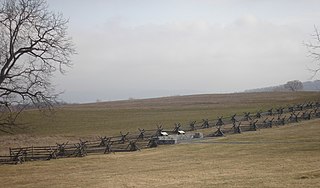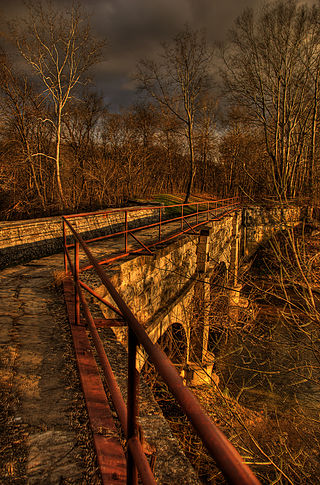Related Research Articles

Antietam National Battlefield is a National Park Service-protected area along Antietam Creek in Sharpsburg, Washington County, northwestern Maryland. It commemorates the American Civil War Battle of Antietam that occurred on September 17, 1862.
America's 11 Most Endangered Places or America's 11 Most Endangered Historic Places is a list of places in the United States that the National Trust for Historic Preservation considers the most endangered. It aims to inspire Americans to preserve examples of architectural and cultural heritage that could be "relegated to the dustbins of history" without intervention.

Principio Furnace and village is in Cecil County, Maryland, 4 miles (6.4 km) northeast of Havre de Grace, MD.

The Nassawango Iron Furnace was built in 1830 by the Maryland Iron Company to produce iron from bog ore deposits in its vicinity. It is notable for its innovative use of a "hot blast" technique for smelting the iron, which had been developed in England around 1828, and which may have been added to the Nassawango Furnace in 1837. Due to the variable nature of the bog ore deposits, the furnace stopped operations in 1849.

The National Archives Site is an archeological site at the National Archives facility in College Park, Prince George's County, Maryland. The site contains archeological remains from prehistoric settlements during the Late Archaic period, c. 4000-1500 B.C. Stone artifacts recovered through archeological testing indicate that this camp served as a place of stone tool manufacture and probably as a staging point for hunting and foraging. Physical integrity of the prehistoric component is high, with little plow disturbance or admixture with artifacts from other periods. The presence of a small number of other artifacts, including the projectile points, a spokeshave, and utilized flakes, indicates that the site also served in other hunting and foraging pursuits. It is one of a relatively small percentage of known prehistoric properties in Maryland with undisturbed archeological deposits.
Nottingham is a small town on the Patuxent River in Prince George's County, Maryland, United States. It contains an archaeological site which was listed on the National Register of Historic Places in 1975.

The Elkridge Furnace Complex is a historic iron works located on approximately 16 acres (6.5 ha) at Elkridge, Howard County, Maryland.
The Elkridge Site, or Elkridge Prehistoric Village Archeological Site, is an archaeological site near Elkridge in Anne Arundel County, Maryland. It is located on a 20-foot (6.1 m) terrace above the Patapsco River and extends 1,200 feet (370 m) along the river and inland from 20 to 400 feet. It is the only known Woodland period riverine-oriented village site in the tidewater Patapsco River valley which has at least partially escaped the totally destructive forces of gravel quarrying. The site appears to have been abandoned as a permanent village in the early 16th century.
The Shawnee Old Fields Village Site, is an archaeological site near Oldtown in Allegany County, Maryland. The site contains Late Woodland and Contact period artifacts. An area between the site and the river's edge may be the location of a number of short-term camps and/or dwelling units. The first confirmed archeological manifestation of the several historically documented Shawnee villages in Maryland. It is believed to have been the home of Chief Opessa Straight Tail, a Shawnee leader.
Buckingham Archeological Site is an archaeological site near Berlin in Worcester County, Maryland. It is one of the few known Woodland period village sites in the coastal marsh areas of the Atlantic Coast section of Maryland. The site falls within the general vicinity of an Assateague Indian town. It is located four miles east of the Sandy Point Site, both including the southernmost reported occurrence of Townsend Series ceramics on the coastal section of the Eastern Shore.
The Sandy Point Site, or Sandy Point Archeological Site, is an archaeological site near Ocean City in Worcester County, Maryland. It contains the southernmost component of the Townsend Series on the Delmarva Peninsula. It is also one of the few known Woodland period village sites in this area. These traits are shared by the nearby Buckingham Archeological Site.
Willin Village Archeological Site is an archaeological site near Eldorado in Dorchester County, Maryland. The Sussex Society of Archeology and History extensively excavated this site between 1951 and 1953. They identified grooved axes and stemmed points indicating use by Archaic peoples. It was possibly the site of a village during the Late Woodland period.
The Heath Farm Camp Archeological Site is an archeological site located near Elkton, Cecil County, Maryland. The site is one of a group of interrelated sites illustrating the various phases of stone tool production and living area activities.
The Iron Hill Cut Jasper Quarry Archeological Site is an archeological site located near Elkton, Cecil County, Maryland, United States. The site is one of a group of interrelated sites illustrating the various phases of stone tool production and living area activities.
The Snow Hill Site is an archeological site located near Port Deposit, Cecil County, Maryland. It was the location of a free African American community, which was established in this area by the mid-19th century. It includes the remains of several structures, a foundation and wall or floorboard, two in situ cast iron stoves, and concentrations of refuse. Only the portion of the site located on the United States Naval Training Center Bainbridge property has been tested. The only remaining standing structure from the community is a two-story, two-family duplex built in the late 19th century, which is located nearby.
Antietam is an unincorporated community and census-designated place in Washington County, Maryland, United States. Its population was 89 as of the 2010 census. It is the site of Antietam Iron Furnace Site and Antietam Village, added to the National Register of Historic Places in 1975.

Harford Furnace Historic District is a national historic district at Bel Air, Harford County, Maryland, United States. It consists of five standing structures and several archeological sites associated with the operation of the iron furnace which began about 1830 and continued to function until 1876. They cover approximately 30 acres (120,000 m2) of rolling land. The district side is both open and wooded and includes land on both sides of James Run, a small south-flowing tributary of the Bush River.

Lonaconing Furnace, also known as The George's Creek Coal and Iron Company Furnace No. 1, is a historic iron furnace in Lonaconing, Allegany County, Maryland, United States. It is a truncated square pyramid constructed of sandstone, 50 feet (15 m) high, 50 feet square at the base, and 25 feet square at the top. It first produced iron in 1839, then the iron operation was abandoned in the mid-1850s, the Loncaconing Furnace complex included a top house, molding house, engine house, and two hot-air furnaces for heating the blast. None of these ancillary structures remains. It played a significant role in demonstrating that both coke and raw bituminous coal could be used as fuels in the manufacture of iron. It is known as "the first coke furnace, whose operation was successful, erected in this country."

Antietam Iron Furnace Site and Antietam Village is a national historic district at Antietam, Washington County, Maryland, United States. It consists of the remains of a mid-18th to late-19th century iron furnace site, and the nearby related village. Remnants of the ironworks include a dam and race, a possible wheel pit or building foundation, the possible location of a furnace stack, and a four-arch stone bridge built by John Weaver in 1832. Also at the site are the dozen or so brick, stone, and wood houses comprising Antietam Village. Typical of the houses is the Mentzer house, a four-bay, two-storey stone structure of roughly coursed fieldstone, painted white.
Accokeek Furnace Archeological Site is a historic archaeological site located near Stafford, Stafford County, Virginia. The Principio Company of Cecil County, Maryland, constructed the Accokeek Iron Furnace about 1726 on land leased from Augustine Washington, father of George Washington. After his death in 1743, his son Lawrence Washington inherited his interest in the company and furnace. When he died in 1752, his share descended to his brother Augustine Washington Jr. Operations at this site ceased around 1753. A historical marker denoting this site is located on the grounds of Colonial Forge High School.
References
- 1 2 "National Register Information System". National Register of Historic Places . National Park Service. April 15, 2008.
- ↑ "Antietam Furnace Complex Archeological Site". Maryland Historical Trust. Retrieved October 29, 2008.

